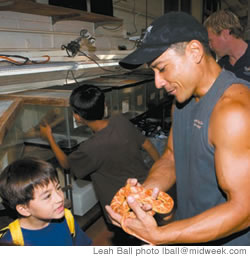BREAKFAST at the ZOO
Meet Mortikai. He’s a 500-pound-plus Aldabra tortoise who’s at least 75 years old, and he really likes bananas. He’ll eat the whole thing, too.

|
Meet Mortikai. He’s a 500-pound-plus Aldabra tortoise who’s at least 75 years old, and he really likes bananas. He’ll eat the whole thing, too.
Mortikai lives at the Honolulu Zoo, and visitors can get to know him a little better through the zoo’s “Breakfast with a Keeper” program. You’d have to go, of course, when the program focuses on reptiles, which was the case when MidWeek tagged along for the November program.
The zoo holds the program twice in the spring - January and March - and twice in the fall - September and November.
“It’s a nice opportunity for folks to learn more about the zoo and see all there is to see,” says Susie Wendland-Gardner, director of education programs for the Honolulu Zoo Society.
“Breakfast with a Keeper” is always on a Saturday morning, and each time focuses on a different type of animal. It starts off with a yummy breakfast of eggs, pancakes, French toast, Spam, fruit, coffee, juice and more good foods to get you energized for your day. For an hour afterwards, you get a “behind-the-scenes” look at the zoo. The group for the November program was small, a suitable size to take through the Reptile House and in to meet the tortoises, including Mortikai.
Glenn Doi, one of the keepers of the tortoise area, tells us that Mortikai is “very active today,” and not to stand too close to him because he could try to sit on your feet, which would probably send you to the emergency room - remember, he does weigh more than 500 pounds. Imagine that sitting down on your little tootsies. Ouch!
“He is an escape artist; we’re constantly finding him on the sidewalks in the zoo. He has a female friend (elsewhere in the zoo),” adds Doi.
“Grass is a big part of his diet, also fruits and vegetables,” Doi continues, while he feeds Mortikai a banana.

|
Prior to meeting Mortikai, our tour actually began after breakfast when we got a firsthand look at the zoo’s new tiger exhibit. Tour guide Jason Tesman tells us the exhibit opened in late November and houses three Sumatra tigers. One of the tigers cannot breed, but the other two - Chrissie, a female, and Berani, a male - are ready to breed. Chrissie and Berani were separated while their new area was being prepared, and now need to be slowly reintroduced.
“When they’re separated, you have to re-establish the relationship. The tigers have to get to know each other again,” says Tesman.” They’ve been together for a couple of hours, four different times. Hopefully by March we’ll have tiger cubs here.”
Since Sumatra tigers normally have three cubs at a time, the zoo is expecting to get three when the tigers breed.
Onward to the alligators we go, getting a look at Goliath and Bob.
Goliath, of course is the larger one.
“Don’t try to touch them,” advises Jason Harris, another tour guide. “(They have) very small muscles to open and close their mouth, but there’s no stopping it. Alligators look exactly like crocodiles, but crocodiles have another nodule on the top of their head; it accommodates a tooth.”
Next, we visit the Galapagos tortoises, the largest of the land tortoises, explains Tesman, who asks if anyone in the group knows how to tell if an animal is a reptile. A little boy raises his hand and spouts out one way to tell - they’re cold blooded.
Tesman, who has been working full time at the zoo since last December, explains that mammals are warm-blooded and their body temperature is always the same. Cold-blooded animals’ temperature is warmer during the day and colder at night. Reptiles also lay eggs, are scaly and “most have four legs or no legs. The skeleton of their body helps them move,” Tesman says. Reptiles also carry salmonella, and they can bite.
On our way to the Reptile House, we observe ring-tailed lemurs, black-and-white-colored primitive primates related to monkeys. They’re from Madagascar, an island off the coast of Africa. These particular lemurs also make some pretty funny poses; it was almost as if they were waving to us.
We are led through the back entrance of the Reptile House, where we meet reptile keeper Kendall Zakahai, or “Mr. Kendall,” as he is introduced to the kids on our little tour.
“We are only going to do small amounts of tasting - seriously, don’t taste anything,” jokes Harris, as we walk into the Reptile House.
Animals in the back are in holding, they’re not on exhibit right now. There’s a frog that several kids say looks dead. but “Mr. Kendall” laughs, assuring us that it’s fine and very much alive.
He also introduces us to “Cob,” a male corn snake - he’s the only snake right now at the Honolulu Zoo. Tesman explains
Page 1 of 2 pages for this story 1 2 >
E-mail this story | Print this page | Comments (0) | Archive | RSS
Most Recent Comment(s):








